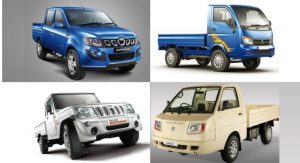India LCV market sees recovery after two-year decline
In an indicator of the improved Indian economy, growth has started filtering down from M&HCVs to the light commercial vehicle (LCV) market. The recovery, albeit slow, is likely to speed up in FY2016-17 thanks to increased infrastructure spend by the government, faster movement of goods across the country by e-retailers and the potential of a regular monsoon season. LCV manufacturers will heave a sigh of relief for they have seen over two years of negative growth, the sector experiencing multiple headwinds like poor monsoon, unavailability of finance, overcapacity and also lower demand. The cyclist nature of the domestic CV industry sees a decline after every 2- 3 years of growth. With the M&HCV sector consistently growing over the last 19 months, it was a matter of time before growth percolated down to the LCV sector. Since the past six months, LCV numbers have been growing consistently although the rate of growth is in single digits.
After recording sharp declines in FY14 and FY15 by 17 and 11 percent respectively, LCVs grew marginally in FY16 by 0.30%, selling a total of 383,331 units YoY (FY15: 382,193 units). The LCV passenger carrier segment has registered 9.2% growth YoY with sale of 48,960 units (FY15: 44,816 units). The LCV goods carrier segment, which is large in volume and has being facing difficulties on multiple fronts, is up marginally by 0.89%, on sales of 334,371 units (FY15: 337,377 units).
As per SIAM’s Q4 FY16 review, LCV demand is expected to pick up in FY17 amidst improving consumption demand and expected ease of financing. The industry body says that following a normal monsoon, there should be strong agricultural freight demand during the kharif harvest season. Sales will also pick up at the fag end of the fiscal due to buyers advancing sales in Q4 FY17 due to the all-India BS IV implementation from April 1, 2017. With consumption expenditure picking up and availability of redistribution freight improving, NPAs would decline and the financing scenario may gradually ease by the first half of FY17. Monthly collection ratios of CV loans have also started showing signs of improvement, and this is expected to provide a boost to CV sales.
OEM gains
All the key manufacturers including Tata Motors, Ashok Leyland, Mahindra & Mahindra, Force Motors, SML Isuzu, Piaggio and VE Commercial Vehicles have seen YoY growth in 2015-16. In the 2-tonne mini-truck segment where Tata Motors is the leader with its popular Ace range, M&M has gained significantly with its new Jeeto range of small trucks and snatched market share from Tata Motors. M&M sold a total 27,843 units, growing by a handsome 82%.(2014-15:15,522 units) and increasing its share in this category from 11.6% to 23.8%. Tata Motors has seen its sales decline by 23.4% to 84,143 units (2014-15: 109,959 units), and market share falling from 83.6% to 72.1%.
In the 2- to 3.5-tonne GVW pick-up segment, M&M’s overall sales declines albeit it continued to have the dominant market share largely due its popular pick-up range. With sales of 126,819 units, M&M now has 69% market share with the two other big players Tata Motors and Ashok Leyland having a near-equal market share.

In the 3.5- to 6-tonne GVW segment, Tata Motors with its hugely popular 407 is the clear market leader with virtually with no competition. With sales of 16,679 units, the company grew its market share to 74.5%. M&M, with its Load King range of trucks, is the other large player in the segment and sold 2,647 units for an 11.8% market share.
In the 6- to 7.5-tonne GVW segment, VE Commercial Vehicles has the largest market share with products like the Eicher 10.59, 10.60 and 10.75 trucks. The company sold 6,376 units in 2015-16, followed by Tata Motors and M&M as the next big players in this category.
Source: http://goo.gl/A2ivV1





Recent Comments